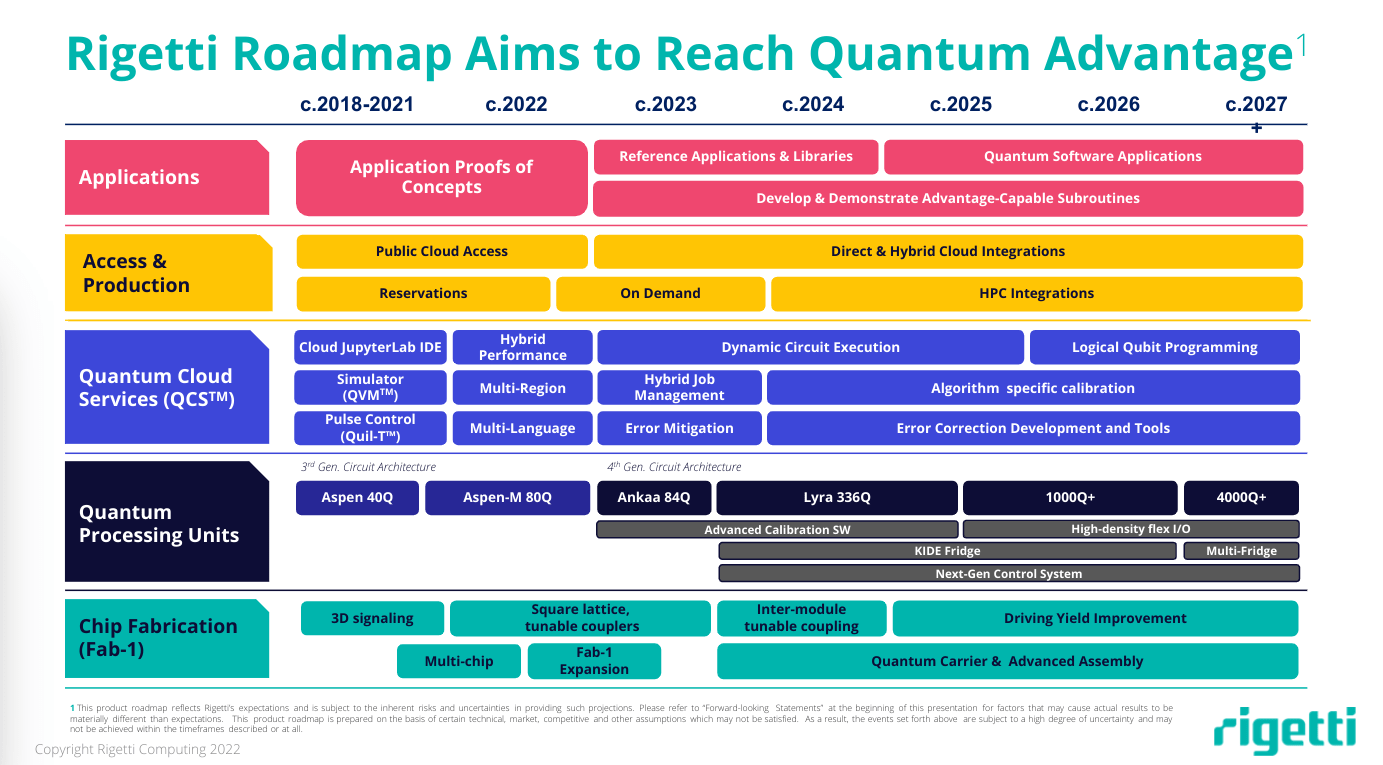Rigetti details new QPU roadmap, fab expansion, Bluefors partnership

At its first public Investors Day event late last week, Rigetti Computing offered up numerous announcements and updates. In addition to saying it remains on track to deliver two new quantum computing systems next year and revealing new names for these systems, the company said it has aligned with Finnish company Bluefors to provide the cryogenic to support future quantum processing units.
Rigetti also said it is expanding its Fab 1 facility in Fremont, California, with clean room space and new testing capabilities. The company also outlined new partnerships with Nvidia, Ampere, and Keysight Technologies, among others (which IQT will cover in a separate story later this week).
As with many investor events, Rigetti’s was implicitly designed to reassure investors who have bought into the company early on, either through the SPAC merger that allowed Rigetti to become a publicly-traded company, or those who have bought the stock since its March debut (and they appear to need reassuring, as the stock sat at a then-low $2.15 per share as Rigetti’s investor event kicked off last Friday). Rigetti’s merger and IPO reportedly did not provide the company with as much funding as it had hoped for, and the company has since been faced with challenges like the delay of a government contract.
Still, Rigetti founder and CEO Chad Rigetti was resolute in stating that his company continues on the right path. “Our decision to be a pure-play full stack company to build this facility, invest in the fab [facility in Fremont], and ultimately own the means of production and focus our effort at the fountainhead of value creation and innovation in the industry has led us to our multi-chip processor architecture… which will unlock performance at scale,” he said.
Rigetti also continues to focus on a hybrid quantum-classical computing model as the most useful model for clients today to leverage quantum processors speed in pursuit of real problems. The CEO said that offering these capabilities through the cloud is the only viable path, given how the state of computing has evolved.
He described the theme of the investors event as “integrating quantum into the fabric of the cloud,” adding, “Our strategy is to let power apply to acknowledge and recognize that all advanced computing today is trending towards a heterogeneous computing model, where not only is there a plurality of processing types available in a single environment, but those processing types can be lined up to the specific needs of a particular workflow that a customer may have. This is best enabled through cloud delivery, and ultimately we’re focused on delivering quantum processors as a new kind of heterogeneous processor within that environment.”
Regarding its next two next-generation systems, Rigetti gave new names to both, with Chad Rigetti saying the 84-qubit Ankaa system is still scheduled to be available in 2023, followed by the multi-chip 336-qubit Lyra system later in the same year. These timelines are consistent with what Rigetti discussed during its last earnings report.
He said the new QPUs will leverage new technologies like “tunable couplers” that, in short will help improve qubit gate fidelity, and a “square lattice” design that will lead to improved qubit connectivity.
Rigetti also shared a roadmap for offerings beyond those two systems, saying “our 1000-qubit-plus system [is scheduled for] 2025, and our 4,000-qubit plus system will appear in 2027 or later. Each of these systems will be associated with the introduction of new enabling technologies.”
A huge element in Rigetti’s “full-stack” pursuit and its ability to execute on that roadmap lies in the expansion its Fab-1 facility, which it expects to be completed late in the fourth quarter of 2022. The build-out includes an additional 5,000 square feet of clean room space for wafer manufacturing, as well as additional capabilities for performing tightly integrated cryo-microwave testing on Rigetti quantum chips.
“When it is completed, we’re going to almost double the space of the current Fab 1,” said Rigetti CEO Mike Harburn. “And this additional space is going to be what really underlies our ability to supply our future in the 2025 and 2027 time periods. And a key aspect of our fabrication capabilities will be that we can take an end of the line product and turn around and get this cryo-microwave test data to help us see how it will perform in a real environment.”
Meanwhile, Rigetti has partnered with cryogenic system developer Bluefors, the Finland-based start-up that IBM also has partnered with to support the development of its IBM Quantum System Two.
Bluefors’ KIDE platform (the same one being used by IBM) initially will support Rigetti’s 336-qubit Lyra system, with the first KIDE coming into Rigetti’s hands in early 2023, and later will be used with the company’s 1,000+-qubit and 4,000+-qubit QPUs.
With all of these elements in place, Rigetti is putting a heavy focus on quantum computing for machine learning applications, which is where Chad Rigetti said the company can make the most difference early on. “We believe quantum advantage will be achieved on an application-by-application basis, and that machine learning will be among the first.”
Dan O’Shea has covered telecommunications and related topics including semiconductors, sensors, retail systems, digital payments and quantum computing/technology for over 25 years.





















